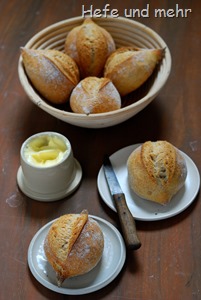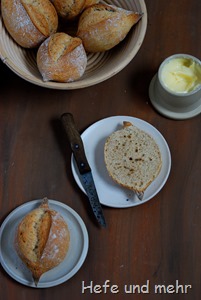 The idea for this rolls started when I pull a nearly forgotten glas with Pâte fermentée from the fridge saturday night. I planed to prepare some sunday morning rolls and so I added some spelt flour (white and and whole grain) for the nutty flavour and egg yolk, butter and milk for a soft crumb. Together with the fermented dough this promised to yield rolls with a deep, complex flavour.
The idea for this rolls started when I pull a nearly forgotten glas with Pâte fermentée from the fridge saturday night. I planed to prepare some sunday morning rolls and so I added some spelt flour (white and and whole grain) for the nutty flavour and egg yolk, butter and milk for a soft crumb. Together with the fermented dough this promised to yield rolls with a deep, complex flavour.
But it was already late at night and so I place the dough in the fridge to rise there until the next morning. Early on Sunday morning I degased the dough, formed the rolls and let them proof for a rather short time. The short proofing made sure that the rolls develope a good oven spring and that the slash opens widely.
The rolls are perfect for a sunday breakfast: beautiful, crisp with soft crumb and as flavourful as they promised to be!
Spitzweckerl
yields 10 rolls
 Pâte Fermentée
Pâte Fermentée
- 150g flour Type 550
- 105g water
- 2g Salt
- 1g fresh yeast
Dough
- Pâte Fermentée
- 100g flour Type 550
- 150g Spelt flour Type 630
- 100g spelt, freshly milled
- 120g Water
- 105g Milk
- 15g egg yolk (of 1 egg size M)
- 8g Salt
- 10g fresh yeast
- 30g Butter
Mix all ingredients for the Pâte Fermentée and let it rise for 1 hour at room temperature. Then put the dough into the fridge for at least 12 hours (up to a week).
Knead all ingredients for about 5 min at slow speed and 6 min at fast speed.
Let the dough rise overnight (at least 12 hours) in the fridge or one hour at room temperature.
Divide the dough into pieces of 80g each. Shape them to oval rolls with pointy tips. Cut them lengthwise very deeply, about 3/4 through the roll. Lay the cut together once again, turn the rolls on the cut and place the rolls on a floured couche.
Proof for 35 min.
Preheat the oven to 250°C.
Turn the rolls, so that the cut side face upside once again, and place them on a paper lined baking tray. Mist with water and bake with steam for about 20 min at 250°C. For really crisp rolls turn to convection mode during the last 5 min.
Deutsch



Hallo Stefanie,
gerade sind die Weckerl im Ofen. 🙂 Leider sind sie nicht so schön spitz geworden wie bei dir. Vermutlich war der Teig zu weich… Da ich keine Getreidemühle habe, habe ich Dinkelvollkornmehl verwendet. Sollte ich die Wasser oder Milchmenge dann besser reduzieren?
Liebe Grüße und einen schönen dritten Advent!
Christin
PS: klasse Blog, super Rezepte
@Christin: Es kann immer mal passieren, dass Mehl weniger Wasser aufnimmt, dass hängt von Wachstumsbedingungen, Luftfeuchtigkeit und einigen andern Faktoren ab. Von daher ist es immer gut, am Anfang beim Kneten etwa 10% Wasser zurückzuhalten und es erst nach und nach zum Teig hinzuzufügen. Dadurch kann man die Schwankungen in der Wasseraufnahme besser ausgleichen.
Knete den Teig beim nächsten Mal erstmal mit 35g Wasser weniger, und schau, wie er sich entwickelt.
Hallo Stefanie,
kann man die Brötchen auch direkt nach dem Kneten fertig formen und auf dem Backblech abgedeckt über Nacht im Kühlschrank gehen lassen, so dass man sie am nächsten Morgen nur noch in den Ofen schieben muss?
@Thilo: Das kannst du machen, der Ofentrieb ist evtl. etwas schwächer, da die Brötchen wahrscheinlich eher mit voller als mit knapper Gare gebacken werden. D.h. der Ausbund wird etwas kleiner. Ich würde die Hefemenge darum auf 6g reduzieren.